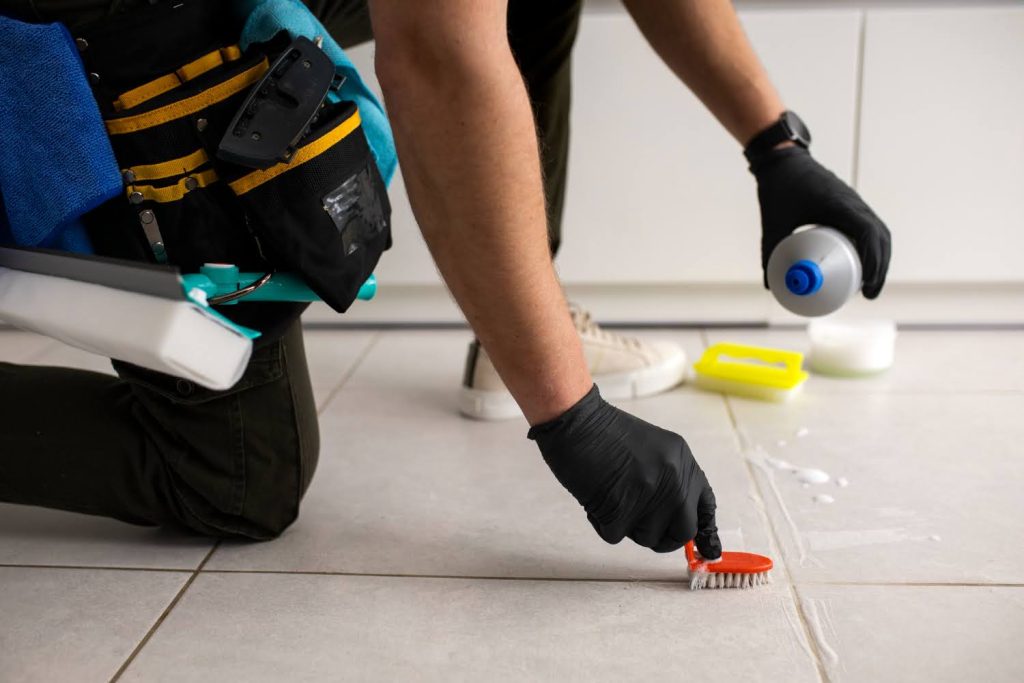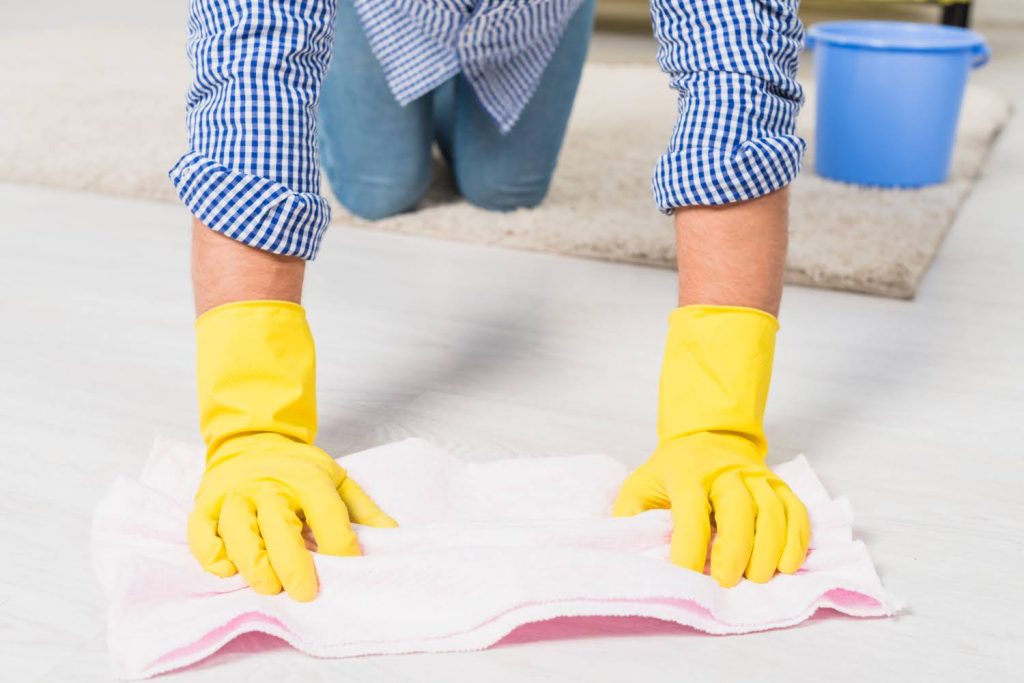Owning a commercial business with marble flooring is a statement of elegance and class, but it comes with its unique set of challenges. These beautiful floors, while durable, require meticulous upkeep to maintain their allure, especially in high-traffic commercial settings.
Business owners often face the task of keeping these floors shining without resorting to heavy machinery, which can be expensive.
It’s important to note that polishing marble floors can effectively be done by hand, using the right cleaning agents and techniques. This approach ensures the floors remain in top shape and offers a cost-effective solution.
This article outlines the step-by-step process on how to polish marble floors even without a machine, ensuring they continue to project the elegance and professionalism your business is known for.

Why Does Marble Become Dull?
Marble floors, with their distinctive streaks and glossy finish, are often chosen by commercial spaces for the aesthetic appeal they bring to settings like hotel lobbies, corporate headquarters, high-end retail stores, and luxury dining establishments.
This natural stone, however, is characteristically porous and relatively soft, making it susceptible to wear and tear. Composed mainly of calcium carbonate, marble floors are prone to staining, scratching, and etching, which can cause them to lose their inherent shine.
- High Foot Traffic: Commercial spaces typically experience high foot traffic. The constant flow of people brings in dirt and small abrasive particles that can gradually wear down the polish on marble floors.
- Frequent Spills and Staining: Spills are inevitable in areas like restaurants and event venues. Substances like wine, coffee, and acidic cleaners can leave stains or etch the surface if not promptly addressed.
- Inadequate Cleaning Methods: Regular cleaning is essential, but using the right techniques and products is crucial. For example, a luxury hotel’s marble lobby might be dull due to improper cleaning agents like vinegar-based solutions that etch the marble.
- Environmental Factors: Elements such as UV light exposure and fluctuating humidity levels can also impact the appearance of marble over time.
Best Cleaners To Polish Marble Floors
Choosing the appropriate cleaner is vital for maintaining the natural elegance of marble floors. The key is to opt for pH-neutral cleaners, which effectively clean the marble without causing damage. Below are some recommended types of pH-neutral cleaners suitable for marble floors:
1. Mild Liquid Dish Soap
Dilute a small amount of a gentle, non-abrasive liquid dish soap in warm water. Use a soft, non-abrasive cloth or mop to apply this solution to the marble floor. This method is safe for regular cleaning as it is gentle on the marble’s surface.
This is great for polishing marble floors because the soap’s ability to break down dirt and grease helps restore the marble’s natural shine and lustre, making it an ideal choice for maintaining the beauty and integrity of marble floors.
2. Hydrogen Peroxide (For Light-Colored Marble)
Hydrogen peroxide effectively removes organic stains (like coffee or wine) on lighter marble. Apply it sparingly directly on the stain, and allow it to sit for a few minutes before gently wiping it off with a damp cloth. Avoid using it for general floor cleaning or on dark marble, as it may lighten the stone.
This method is excellent for polishing marble floors because hydrogen peroxide acts as a mild bleaching agent, which can brighten and rejuvenate the appearance of light-coloured marble without being too harsh.
3. Acetone (For Dark-Colored Marble)
Acetone is highly effective for polishing dark-coloured marble floors, particularly in removing tough, oil-based stains that other cleaners cannot tackle. Unlike bleaching agents, it is especially suitable for dark marble as it does not cause discolouration.
Apply a small amount directly on the stain and blot gently with a soft cloth. Rinse the area with water after the stain lifts. Note that acetone can strip sealers, so resealing the treated area might be necessary.
4. Baking Soda (For Occasional Deep Cleaning)
A paste made from baking soda and water can be effective for tough stains. Mix baking soda with a small amount of water to form a thick paste.
Apply this paste to the stain, cover it with plastic wrap, and let it sit overnight. Gently wipe and rinse the area the next day. This method should be used sparingly to avoid etching the marble.
NOTE: It’s crucial to avoid acidic substances like vinegar, lemon juice, or ammonia-based cleaners on marble floors. Marble, being primarily composed of calcium carbonate, reacts chemically with acids.
This reaction, known as acid etching, dissolves the calcium carbonate in the marble, leading to dull spots, pitting, and a general loss of shine.
The damage caused by acid etching can be significant and often requires professional restoration. Therefore, always test any cleaner on a small, inconspicuous area of the floor first to ensure it doesn’t harm the marble.

A Step-By-Step Guide To Polishing Marble Floors By Hand
Preparing marble floors for polishing is a crucial process that involves meticulous cleaning to ensure that the polishing is effective and enhances the stone’s natural beauty. Here are the steps you need to follow:
1. Sweep The Floor To Clean Any Loose Dirt And Debris
The initial step involves thoroughly sweeping the floor to remove any loose dirt, dust, and debris. This is a critical step because any residual particles can scratch the marble surface during the subsequent wet cleaning process.
Using a soft-bristled broom or a microfiber dust mop is recommended for this task. Avoid using brooms with stiff bristles or vacuums with worn or hard attachments, as these can cause scratches on the marble surface.
2. Mop The Floor To Remove Stuck-On Grime
After sweeping, the next step is to mop the floor. Use a well-wrung damp mop to apply a commercial marble cleaner or a mild, non-abrasive dishwashing liquid diluted in water.
The goal is to clean the floor thoroughly without leaving excess water on the surface, as standing water can penetrate and stain the marble. When mopping, it’s essential to use a soft mop and frequently change the cleaning solution to prevent spreading dirt.
3. Remove Stains Before Polishing
Before polishing, it is crucial to treat any stains on the marble, a common occurrence in commercial settings with high foot traffic. For this, a poultice is highly effective.
A poultice is a paste-like cleaning agent that draws out stains from porous materials like marble. It penetrates the surface and breaks down the stain particles, which are then absorbed into the poultice material. To make a poultice for marble:
- Mix about three parts of baking soda with one part of water to create a thick paste.
- Apply this paste directly onto the stain using a plastic spatula or spoon.
- Cover the poultice with plastic wrap, sealing the edges with painter’s tape to keep it intact.
- Leave it on for about 24 hours, during which the poultice will draw the stain out from the marble.
- After 24 hours, gently remove the poultice and clean the area with a damp cloth.
This method effectively removes organic stains, such as those from food or drinks, and light oil-based stains. It is particularly useful in commercial environments like restaurants, hotels, and public lobbies, where such spills are common.
However, a commercial poultice specifically formulated for that type of stain may be necessary for older or more stubborn stains, especially acidic ones. Professional commercial cleaning services may be needed if a stain persists after treatment.
4. Choosing The Right Polish For Marble Floors
When selecting a polish for marble floors in commercial spaces, understanding the type of finish and its appropriate environment is key.
- High-Gloss Finish: For a high-gloss finish commonly seen in luxury hotels and high-end retail spaces, a product like the ‘StonePro High Gloss Finish Sealer’ is ideal. This type of polish accentuates the reflective sheen of the marble, making it stand out in areas where luxury and elegance are paramount.
- Honed (Matte) Finish: In contrast, honed or matte finishes, which are common in corporate offices and art galleries, require a different approach. A polish like ‘Tenax Matte Stone Sealer’ is suitable here. It maintains the marble’s natural, understated sheen without adding gloss, aligning with the professional and sophisticated atmosphere of such spaces.
- Antiqued or Tumbled Finish: A gentle polish is necessary for antiqued or tumbled finishes, often chosen for their rustic appeal in cafes and themed restaurants. ‘Lithofin MN Easy-Care’ is a great choice as it preserves the textured appearance without detracting from the marble’s aged character.
- Satin Finish: Satin-finished marble, typically found in banquet halls and convention centres, needs a balanced polish like ‘Miracle Sealants Water-Based Sealer’. This product enhances the floor’s natural sheen without pushing it into high-gloss territory, making it perfect for spaces that demand a touch of elegance without overwhelming shine.
- Brushed Finish: Lastly, brushed finish marble, common in shopping malls and public areas, requires a polish that can handle its unique texture. ‘Aqua Mix Sealer’s Choice Gold’ is a good option, as it enhances the stone’s appearance while respecting its intentionally textured surface.

5. Applying Polish On Marble Floors
Polishing marble floors, especially in commercial settings, requires a systematic approach to ensure a flawless finish. Once you’ve found the right polish for your marble flooring, follow these detailed steps for optimal results:
- Preparing the Area: Clear the space of furniture or rugs to ensure unobstructed access to the entire floor. It’s important to ensure good ventilation in the area to prevent the buildup of any fumes from the polish, which is especially crucial in commercial spaces where health and safety are paramount.
- Applying the Polish: Start by applying a small amount of your chosen polish onto a cloth or sponge. Begin in a corner of the room and work in small sections. This controlled approach helps maintain consistency and ensures that you don’t miss any spots.
Gently rub the polish onto the marble using circular, overlapping motions for even coverage and to avoid creating streaks.
- Addressing Tough Spots: If you encounter tougher spots or slight surface imperfections, use a non-abrasive pad. Apply gentle pressure to these areas, being careful not to scratch or damage the marble surface. This step is crucial for achieving a uniform polish across the entire floor.
- Rinsing the Floor: After polishing each section, rinse the area with clean water. You can use a damp mop or cloth for this purpose. It’s important to remove any remaining polish to prevent a filmy residue, which can mar the appearance of the marble.
- Drying the Floor: Post-rinsing, dry the floor using a dry, soft cloth or mop. This step is crucial to prevent water spots on the marble, particularly in well-lit commercial spaces.
- Repeat as Necessary: Continue working section by section until the entire floor is polished, rinsed, and dried. This meticulous process ensures that the entire floor is evenly polished and maintains its lustre.
Also, be mindful not to exert excessive pressure while polishing, as this can damage the marble. Change your cleaning cloths or sponges regularly to avoid spreading dirt or debris back onto the floor.
6. Buffing To Enhance The Marble’s Natural Shine
Buffing is an essential part of the marble floor polishing process, particularly in commercial spaces where aesthetics play a significant role. It’s the act of using a soft material to rub the marble surface, which enhances the shine and smooths out any remaining imperfections from the polishing phase.
- Prepare A Clean, Dry Microfiber Cloth: For buffing, you’ll need clean, dry microfiber cloths. Microfiber is ideal because of its soft texture and ability to attract and hold dirt and grime without scratching the surface.
The purpose of using these cloths is to bring out the stone’s natural shine, remove any residual polishing compound, and smooth the surface to a uniform finish.
- Start Buffing The Polished Marble Surface: Take a fresh microfiber cloth and gently buff the polished surface. Use circular motions, which help distribute the pressure evenly and uniformly enhance the shine.
Start from one section of the floor and gradually move to the next, ensuring that each area receives equal attention.
It’s particularly important to focus on the edges and corners of the floor. These areas often get overlooked during the polishing phase and require careful buffing to match the sheen of the rest of the floor.
- Switch To A Fresh Cloth (If Necessary): As you buff the floor, be vigilant about the cloth’s cleanliness. A dirty cloth can redeposit dirt onto the floor, counteracting your buffing efforts.
This is especially crucial in commercial settings where the floor’s appearance can significantly impact the overall look and feel of the space. Regularly switch to a fresh cloth when the ones you use become dirty.
- Apply Gentle Pressure: It’s important to apply gentle pressure while buffing. Excessive force can lead to surface scratches, marring the newly polished marble.
Also, be consistent in your movements to avoid creating swirl marks on the floor. The aim is to achieve a consistently polished, shiny surface that enhances the room’s aesthetics.
7. Maintaining Marble Flooring
This step involves a diligent cleaning regimen and preventive strategies. Regular dust mopping is essential to remove surface dirt and prevent scratches, and immediate cleaning of spills is crucial to avoid staining on the porous marble surface.
Using pH-neutral cleaners ensures effective cleaning without damaging the marble, and thoroughly drying the floor post-cleaning prevents water spots. Avoid acidic cleaners, as these can etch the surface.
Preventive measures are equally important in preserving marble floors. Entry mats at all entrances can significantly reduce the amount of abrasive materials like sand and stones that get tracked in, thus protecting the floor from scratches.
Additionally, placing protective pads under furniture prevents scratches and etches, especially when furniture is moved. Regularly checking and replacing these pads ensures continuous protection for the marble flooring. By following these practices, marble floors’ longevity and aesthetic appeal in commercial areas can be significantly enhanced.
Conclusion On How To Polish Marble Floors Without A Machine
Polishing marble floors by hand is a meticulous but rewarding process. It restores the marble’s shine and extends its life, especially in high-traffic commercial settings.
However, in certain situations, professional intervention may be necessary. This includes dealing with deep stains, large scratches, or when the marble has lost its shine despite regular maintenance.
You can rely on ESP Cleaning if you’re looking for reliable commercial cleaning service providers. We have a team of experienced cleaners that can help maintain the cleanliness of your commercial space. To get started, you can request a non-obligatory quote from us.
Frequently Asked Questions About How To Polish Marble Floors Without A Machine
How Often Should Marble Floors Be Polished In A High-Traffic Commercial Space?
In high-traffic commercial areas, marble floors should be polished more frequently, typically every 6 to 12 months, depending on the level of foot traffic and wear. Regular polishing helps maintain the floor’s lustre and prevents the build-up of grime and scratches in busy environments.
What Should I Do If The Marble Floor Loses Its Shine After Polishing?
If a marble floor loses its shine after polishing, it may need a deeper cleaning or a different polishing technique. Consider re-cleaning the floor with a suitable pH-neutral cleaner and re-polishing using a high-quality marble polish. If the problem persists, consult a professional; the floor may require re-honing or more intensive treatment.
Is It Safe To Use A Steam Cleaner To Clean Marble Floors Before Polishing?
Using a steam cleaner on marble floors is generally not advised. The heat and moisture from steam cleaning can cause damage, such as cracking or spalling, especially if the marble is not properly sealed. It’s safer to stick to traditional mopping with suitable cleaning solutions for pre-polishing cleaning.
Can DIY Polishing Provide The Same Results As Professional Marble Floor Polishing?
While DIY polishing can maintain the appearance of marble floors, professional polishing often yields better and more durable results. Professionals use specialised equipment and techniques to achieve a higher level of shine and finish. Professional services are recommended for optimal results for high-end commercial spaces or heavily worn floors.

